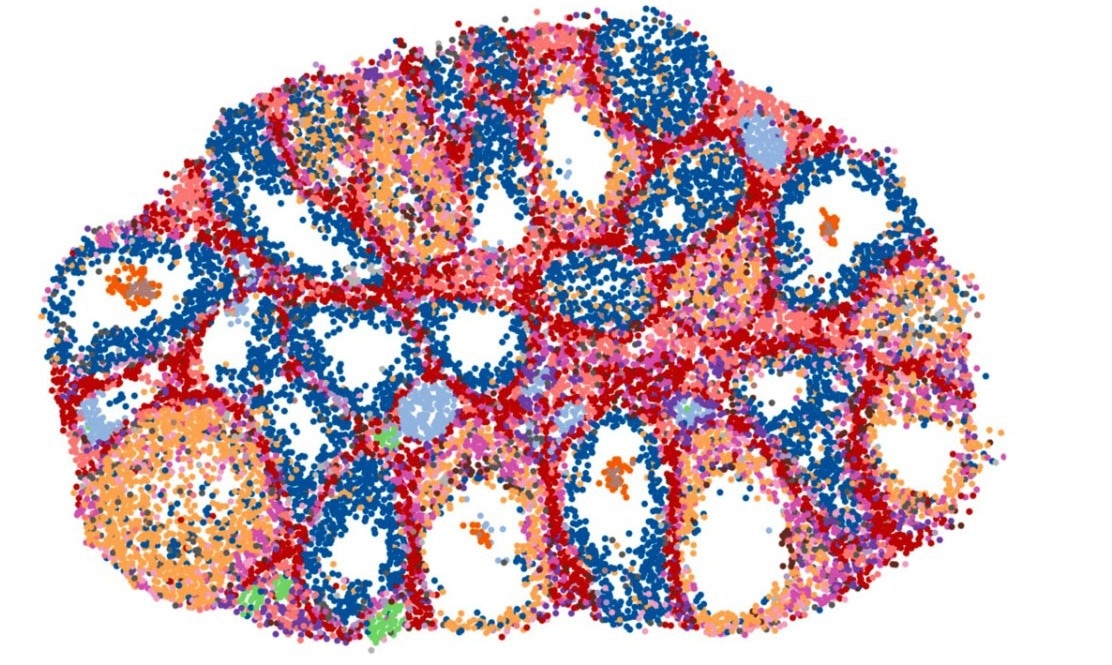Reviewed by Danielle Ellis, B.Sc.Jan 24 2024
An interdisciplinary team mapped the gene expression that takes place in mice during follicle maturation and ovulation using a state-of-the-art method of RNA tagging.
 This spatial transcriptomics map depicts the cell types of a mouse ovary undergoing hormone-induced ovulation. Image Credit: Cornell University
This spatial transcriptomics map depicts the cell types of a mouse ovary undergoing hormone-induced ovulation. Image Credit: Cornell University
The resultant atlas unveils a plethora of hitherto unidentified molecular and cellular processes that propel ovulation, an essential process for female fertility. The results may be essential for creating effective infertility treatments.
Iwijn De Vlaminck, an Associate Professor of Biomedical Engineering at Cornell Engineering, and Yi Athena Ren, an Assistant Professor of Animal Science at the College of Agriculture and Life Sciences, led the research, which was published on January 22nd, 2024, in the Proceedings of the National Academy of Sciences. Madhav Mantri, Ph.D. ‘23, who is currently a Postdoctoral Researcher at Stanford University, is the lead author of the paper.
De Vlaminck previously surveyed the whole spectrum of RNA in mouse tissues using the imaging technique known as high-resolution spatiotemporal transcriptomics. This revealed the involvement of elusive RNA in viral myocarditis and skeletal muscle regeneration. In essence, transcriptomics is the process of converting RNA into copies of DNA that are tagged with barcodes to record their spatial location. This information can subsequently be sequenced to create an image.
In 2022, Ren attended the 2nd Intercampus Immunology Symposium, where De Vlaminck presented the findings on myocarditis. She found De Vlaminck's method intriguing and pondered whether it could be used to address one of her main passions: figuring out the cellular and molecular processes that control ovulation.
The precise timing of the release of female germ cells, or oocytes, through the rupture of ovarian follicles - which provide the growth and maturation environment for oocytes - is essential for ovulation. This rupture happens roughly every four weeks in women, but every four to five days in mice. When oocytes leave the ovary, they quickly expire, so when to release them is crucial.
Ovarian follicles are like launching pads, and the ovary is like the ground control. Together they prepare the eggs for fertilization at the right time and right location. All the different cell types in the ovary must work together through an amazingly complex and dynamic ‘social network’ that involves intricated communication between all cells. That’s the power of Iwijn’s technology. It combines high resolution in both time and space. So those two really capture the essence of ovulation.”
Yi Athena Ren, Assistant Professor, Animal Science, College of Agriculture and Life Sciences
Transcriptomics’ spatial resolution has improved tenfold in the years since De Vlaminck's myocarditis study, from 100 micrometers to 10 microns per pixel. This improvement has brought transcriptomics’ resolution close to single-cell levels. But the drawback of having so much data is that it can be intimidating to sort through it all.
We had about 10 images and we spent a good 10 months making sense of them.”
Iwijn De Vlaminck, Associate Professor, Biomedical Engineering, Cornell Engineering
The scientists translated hundreds of millions of DNA molecules into a matrix of gene expression for each image after sequencing the molecules. The expression levels of all 22,000 mouse protein-coding genes were represented in each pixel. Increase that by about 100,000 pixels. And that was just the start.
De Vlaminck says, “You have to turn that data into biological findings, look at temporal patterns, fish out specialized cell states, and so on. It’s not just like a normal microscopy image where you have the image, and that’s it, you see what you see.”
Among the discoveries, the atlas shows that the follicles go through an extra layer of selection to determine which ones will ovulate about an hour before an egg is released. This acute process was previously unknown, and if it goes wrong, it can impair fertility and cause a decrease in ovulation rates.
Early differentiation markers that determine the various routes cells may take in the ovary were also found by the researchers. Essentially, both the extremely early and extremely late phases of ovulation are captured by the atlas' dynamic cellular and molecular regulation programs.
This type of atlas provides so much more detail about where and when all the molecular changes happen in the ovary, details that were difficult to capture using other methodologies. So that may inspire new interventions that target specific molecules we identify, for example, specific genes that are important for fertility management.”
Iwijn De Vlaminck, Associate Professor, Biomedical Engineering, Cornell Engineering
Faculty members at the Cornell Reproductive Sciences Center De Vlaminck and Ren now intend to expand their partnership by investigating issues related to ovulation and fertility that arise from obesity and aging of the reproductive system.
The researchers found that ovulation failure - which is made worse by rising obesity and maternal age - is the cause of over 10% of infertility cases in the United States alone.
De Vlaminck says, “There is a growing interest at Cornell in these types of problems, where we can use cutting-edge engineering principles for reproductive medicine – an area where those cutting-edge tools are not used as much, or as early, as in some other fields, like cancer biology, for instance.”
Source:
Journal reference:
Mantri, M., et al. (2024). A spatiotemporal molecular atlas of the ovulating mouse ovary. Proceedings of the National Academy of Sciences. doi.org/10.1073/pnas.2317418121.